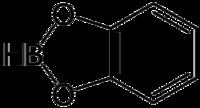Formula C6H5BO2 Density 1.12 g/cm³ Melting point 12 °C | Molar mass 119.92 g/mol Boiling point 50 °C Appearance Colorless liquid | |
 | ||
Catecholborane (abbreviated HBcat) is an organoboron compound that is useful in organic synthesis. This colourless liquid is a derivative of catechol and a borane, having the formula C6H4O2BH.
Contents
Synthesis and structure
Traditionally catecholborane is produced by treating catechol with borane (BH3) in a cooled solution of THF. However, this method results in a loss of 2 mole equivalents of the hydride. Nöth and Männig devised a more economical method involves the reaction of alkali-metal boron hydride (LiBH4, NaBH4, of KBH4) with tris(catecholato)bisborane in an ethereal solvent such as diethyl ether. In 2001 Herbert Brown released an additional procedure for catecholborane synthesis. His method involves treating tri-O-phenylene bis-borate with diborane in a solution of either triglyme or tetraglyme. Brown claimed his method produces 85% yield of 97% pure product, catecholborane.
Unlike borane itself or alkylboranes, catechol borane exists as a monomer. This behavior is a consequence of the electronic influence of the alkoxy groups that diminish the Lewis acidity of the boron centre. Pinacolborane adopts a similar structure.
Reactions
Catechol borane is less reactive than borane itself.
Preparation of an organoborane
When catecholborane is treated with an alkyne, usually a terminal alkyne, through hydroboration a trans vinylborane is formed. The product is a precursor to the Suzuki reaction.
Reduction of β-hydroxy ketones
Catecholborane may be used as a stereoselective reducing agent when converting β-hydroxy ketones to syn 1,3-diols.
